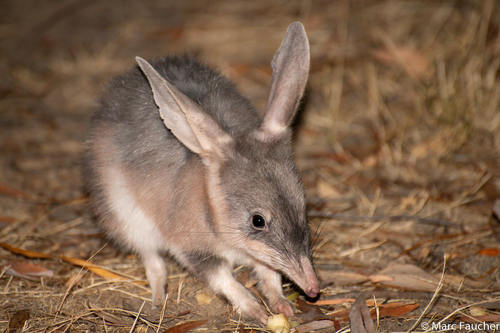
Greater Bilby
The Greater Bilby, with its distinctive large ears and long snout, is a desert-dwelling marsupial known for its nocturnal foraging habits. Its burrowing enriches soil health, underscoring its ecological importance. Despite its adorable appearance, this species is a vital contributor to Australia's arid ecosystems.
10 years
Lifespan
594.0 - 2490.0 g
Weight
Length: 29 - 55 cm
Size
Grey, Blue
Color
5 months
Age of Sexual Maturity
75 days
Age of Weaning
Vulnerable
Conservation Status
Decreasing
Population Trend
Characteristics
Macrotis lagotis, commonly known as the Greater Bilby, is a nocturnal marsupial native to arid regions of Australia. It has large ears for thermoregulation, a long snout for foraging, and a silky blue-grey coat. Bilbies are omnivorous, feeding on insects, seeds, and bulbs, and play a role in soil aeration through their digging.
Distribution Range of the Greater Bilby
Macrotis lagotis, commonly known as the Greater Bilby, is native to Australia. Historically, its range extended across 70% of the Australian mainland, but now it is primarily found in isolated pockets within the arid and semi-arid regions of Western Australia, the Northern Territory, and Queensland.
Greater Bilby's Habitat
Environmental Conditions
The Greater Bilby inhabits arid and semi-arid environments, which include grasslands, woodlands, and shrublands. These areas typically experience low rainfall, high temperatures, and have sandy or clay soils which are suitable for burrowing.
Ecological Niche
The Greater Bilby is a nocturnal marsupial that plays a critical role in its ecosystem as both a consumer of seeds, bulbs, and insects, and as a prey species for native predators. Its burrowing behavior aids in soil aeration and seed dispersal, contributing to the ecological health of its habitat.
Copyright @ Nature Style Limited. All Rights Reserved.
 English
English